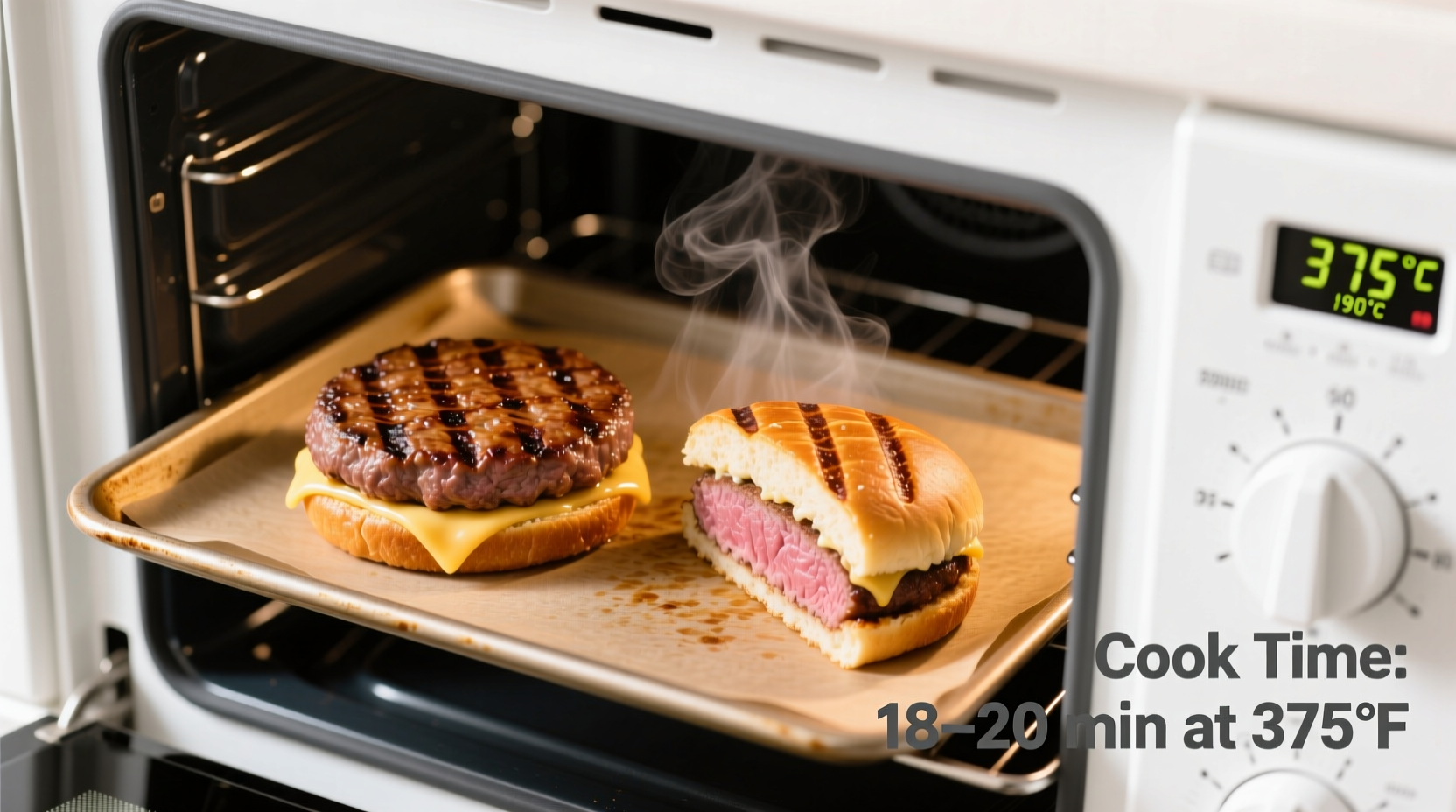Ever wonder why your oven-baked burgers turn out dry or undercooked? You're not alone. Getting perfect oven burgers requires understanding the precise relationship between temperature, thickness, and timing. This guide delivers exactly what home cooks need: science-backed timing guidelines, visual doneness indicators, and professional techniques that guarantee juicy, safe burgers every time you fire up your oven.
Why Oven Cooking Beats Guesswork
Unlike grilling or pan-frying, oven baking provides consistent, even heat that eliminates hot spots and flare-ups. Food safety experts at the USDA confirm that oven cooking reduces the risk of uneven doneness that can lead to foodborne illness. The controlled environment allows precise timing that adapts to your specific burger variables.
Key Factors That Determine Your Cooking Time
Before we get to exact timing, understand these critical variables that affect your burger's cooking time:
- Oven temperature: 375°F yields juicier results; 400°F creates better browning
- Patty thickness: ½-inch vs. 1-inch changes timing by 5-10 minutes
- Starting temperature: Cold patties from the fridge need 2-3 minutes longer
- Rack position: Middle rack ensures even heat circulation
- Tray type: Wire racks promote airflow for more even cooking than baking sheets
Step-by-Step Perfect Burger Method
Follow this professional technique for consistently excellent results:
- Prep your patties: Form ¾-inch thick patties slightly wider than your bun (they'll shrink)
- Preheat oven: Set to 375°F for standard burgers or 400°F for extra browning
- Prepare baking surface: Place wire rack on baking sheet lined with parchment
- Season and position: Lightly oil patties, place on rack with space between
- Bake without flipping: Cook undisturbed for best results (no need to flip in oven)
- Check temperature: Insert thermometer horizontally into side of patty
Precise Timing Guidelines by Thickness
These times apply to standard beef burgers at 375°F. Increase by 5 minutes at 400°F for faster cooking with more browning.
| Patty Thickness | 375°F Cooking Time | 400°F Cooking Time | Target Internal Temp |
|---|---|---|---|
| ½ inch | 12-15 minutes | 10-13 minutes | 160°F |
| ¾ inch | 15-18 minutes | 13-16 minutes | 160°F |
| 1 inch | 18-22 minutes | 16-20 minutes | 160°F |
Note: These times are starting points. Always verify with a meat thermometer as oven temperatures vary.
Food Safety: The Non-Negotiable Temperature Rule
The USDA Food Safety and Inspection Service mandates that ground beef must reach 160°F internal temperature to eliminate harmful bacteria like E. coli. Unlike steaks, burgers require full cooking through because grinding distributes surface bacteria throughout the meat. A study by the Journal of Food Protection confirmed that visual cues alone (like color change) are unreliable indicators of doneness - 25% of burgers appearing done were still under 160°F.

When to Pull Burgers Early
Burgers continue cooking from residual heat after removal from the oven (carryover cooking). For optimal juiciness:
- Pull burgers at 155°F if using a high-quality thermometer (they'll reach 160°F while resting)
- Always rest burgers for 5 minutes before serving
- Never press burgers with a spatula - this squeezes out precious juices
Troubleshooting Common Oven Burger Issues
Dry burgers: Overcooked due to high oven temperature or excessive time. Solution: Reduce temperature to 350°F and check early.
Uneven cooking: Caused by inconsistent patty thickness. Solution: Use a burger press for uniform patties.
Poor browning: Oven not hot enough or patties too cold. Solution: Preheat thoroughly and let patties sit at room temperature for 15 minutes before baking.
Special Considerations for Different Burger Types
Turkey/chicken burgers: Require higher internal temperature (165°F) and typically need 5 minutes longer due to lower fat content.
Veggie burgers: Follow package instructions, but generally cook 10-15 minutes at 375°F. They don't require a specific internal temperature.
Cast iron alternative: For restaurant-style sear, finish burgers under broiler for 1-2 minutes after oven baking.
Pro Tips for Next-Level Results
Professional chefs use these techniques to elevate oven burgers:
- Chill patties before baking: 30 minutes in freezer prevents spreading
- Add moisture boosters: Mix 1 tablespoon Worcestershire sauce per pound of meat
- Season after shaping: Salt too early draws out moisture and creates tough burgers
- Use convection setting: If available, reduces cooking time by 25% with more even results
Why Oven Beats Other Cooking Methods
While grilling has its place, oven baking offers distinct advantages confirmed by culinary research:
- Consistency: No flare-ups or hot spots that cause uneven cooking
- Hands-off: No flipping required and minimal monitoring
- Weather proof: Works perfectly regardless of outdoor conditions
- Safety: Reduced risk of foodborne illness from uneven cooking
Final Timing Checklist
Before you bake, verify these timing essentials:
- Preheat oven for at least 15 minutes before baking
- Use an oven thermometer to verify actual temperature
- Measure patty thickness with ruler for accurate timing
- Insert meat thermometer horizontally into side of patty
- Rest burgers 5 minutes before serving for juiciest results











 浙公网安备
33010002000092号
浙公网安备
33010002000092号 浙B2-20120091-4
浙B2-20120091-4